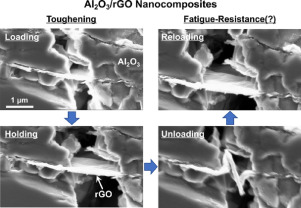当前位置:
X-MOL 学术
›
Acta Mater.
›
论文详情
Our official English website, www.x-mol.net, welcomes your feedback! (Note: you will need to create a separate account there.)
Fracture, Fatigue, and Sliding-Wear Behavior of Nanocomposites of Alumina and Reduced Graphene-Oxide
Acta Materialia ( IF 9.4 ) Pub Date : 2020-03-01 , DOI: 10.1016/j.actamat.2019.12.035 Qizhong Wang , Cristina Ramírez , Connor S. Watts , Oscar Borrero-López , Angel L. Ortiz , Brian W. Sheldon , Nitin P. Padture
Acta Materialia ( IF 9.4 ) Pub Date : 2020-03-01 , DOI: 10.1016/j.actamat.2019.12.035 Qizhong Wang , Cristina Ramírez , Connor S. Watts , Oscar Borrero-López , Angel L. Ortiz , Brian W. Sheldon , Nitin P. Padture

|
Abstract There is growing interest in using 2D graphene-related reinforcements to toughen brittle ceramics in nanocomposites. However, there is a lack of fundamental understanding of the toughening mechanisms and microstructural effects in such nanocomposites. To address this paucity, fully-dense nanocomposites of aluminum oxide (Al2O3) matrix and reduced graphene-oxide (rGO) reinforcements (~5 vol%) of different average-thicknesses and orientations are fabricated and characterized. The interactions between stably propagating cracks and rGO in the Al2O3/rGO nanocomposites are observed in situ inside a scanning electron microscope (SEM). Toughening by pullout of thick rGO in the crack-tip wake in the cross-section orientation is found to be the most effective, which is consistent with the highest fracture toughness (KIC~6.7 MPa.m0.5) measured in those Al2O3/rGO nanocomposites. Interestingly, upon unloading and reloading, the intact rGO crack-bridges appear to crinkle and uncrinkle without a remnant crease, respectively, which is a unique deformation property of multi-layer graphene-like materials. This points to a possible new cyclic-fatigue resistance mechanism in those nanocomposites. Sliding-wear properties of the Al2O3/rGO nanocomposites are also studied, where the hardness and microstructural heterogeneities are found to play dominant roles. The results from this study have implications for the creation of high-toughness, fatigue-resistant, and wear-resistant graphene-reinforced ceramic nanocomposites of the future.
中文翻译:

氧化铝和还原氧化石墨烯纳米复合材料的断裂、疲劳和滑动磨损行为
摘要 使用二维石墨烯相关增强材料来增韧纳米复合材料中的脆性陶瓷越来越受到关注。然而,对这种纳米复合材料的增韧机制和微观结构效应缺乏基本的了解。为了解决这种缺乏问题,制造并表征了氧化铝 (Al2O3) 基质和还原氧化石墨烯 (rGO) 增强材料 (~5 vol%) 的全致密纳米复合材料。在扫描电子显微镜 (SEM) 内原位观察 Al2O3/rGO 纳米复合材料中稳定扩展的裂纹与 rGO 之间的相互作用。发现通过在横截面方向的裂纹尖端尾流中拉出厚 rGO 来增韧是最有效的,这与最高的断裂韧性 (KIC~6.7 MPa.m0. 5) 在这些 Al2O3/rGO 纳米复合材料中测量。有趣的是,在卸载和重新加载时,完整的 rGO 裂纹桥似乎分别起皱和展开而没有残余折痕,这是多层类石墨烯材料的独特变形特性。这表明这些纳米复合材料可能存在一种新的抗循环疲劳机制。还研究了 Al2O3/rGO 纳米复合材料的滑动磨损性能,发现硬度和微观结构的不均匀性起主导作用。这项研究的结果对未来高韧性、耐疲劳和耐磨的石墨烯增强陶瓷纳米复合材料的创造具有重要意义。完整的 rGO 裂纹桥似乎分别在没有残余折痕的情况下起皱和解开,这是多层石墨烯类材料的独特变形特性。这表明这些纳米复合材料可能存在一种新的抗循环疲劳机制。还研究了 Al2O3/rGO 纳米复合材料的滑动磨损性能,发现硬度和微观结构的不均匀性起主导作用。这项研究的结果对未来高韧性、耐疲劳和耐磨的石墨烯增强陶瓷纳米复合材料的创造具有重要意义。完整的 rGO 裂纹桥似乎分别在没有残余折痕的情况下起皱和解开,这是多层石墨烯类材料的独特变形特性。这表明这些纳米复合材料可能存在一种新的抗循环疲劳机制。还研究了 Al2O3/rGO 纳米复合材料的滑动磨损性能,发现硬度和微观结构的不均匀性起主导作用。这项研究的结果对未来高韧性、耐疲劳和耐磨的石墨烯增强陶瓷纳米复合材料的创造具有重要意义。还研究了 Al2O3/rGO 纳米复合材料的滑动磨损性能,发现硬度和微观结构的不均匀性起主导作用。这项研究的结果对未来高韧性、耐疲劳和耐磨的石墨烯增强陶瓷纳米复合材料的创造具有重要意义。还研究了 Al2O3/rGO 纳米复合材料的滑动磨损性能,发现硬度和微观结构的不均匀性起主导作用。这项研究的结果对未来高韧性、耐疲劳和耐磨的石墨烯增强陶瓷纳米复合材料的创造具有重要意义。
更新日期:2020-03-01
中文翻译:

氧化铝和还原氧化石墨烯纳米复合材料的断裂、疲劳和滑动磨损行为
摘要 使用二维石墨烯相关增强材料来增韧纳米复合材料中的脆性陶瓷越来越受到关注。然而,对这种纳米复合材料的增韧机制和微观结构效应缺乏基本的了解。为了解决这种缺乏问题,制造并表征了氧化铝 (Al2O3) 基质和还原氧化石墨烯 (rGO) 增强材料 (~5 vol%) 的全致密纳米复合材料。在扫描电子显微镜 (SEM) 内原位观察 Al2O3/rGO 纳米复合材料中稳定扩展的裂纹与 rGO 之间的相互作用。发现通过在横截面方向的裂纹尖端尾流中拉出厚 rGO 来增韧是最有效的,这与最高的断裂韧性 (KIC~6.7 MPa.m0. 5) 在这些 Al2O3/rGO 纳米复合材料中测量。有趣的是,在卸载和重新加载时,完整的 rGO 裂纹桥似乎分别起皱和展开而没有残余折痕,这是多层类石墨烯材料的独特变形特性。这表明这些纳米复合材料可能存在一种新的抗循环疲劳机制。还研究了 Al2O3/rGO 纳米复合材料的滑动磨损性能,发现硬度和微观结构的不均匀性起主导作用。这项研究的结果对未来高韧性、耐疲劳和耐磨的石墨烯增强陶瓷纳米复合材料的创造具有重要意义。完整的 rGO 裂纹桥似乎分别在没有残余折痕的情况下起皱和解开,这是多层石墨烯类材料的独特变形特性。这表明这些纳米复合材料可能存在一种新的抗循环疲劳机制。还研究了 Al2O3/rGO 纳米复合材料的滑动磨损性能,发现硬度和微观结构的不均匀性起主导作用。这项研究的结果对未来高韧性、耐疲劳和耐磨的石墨烯增强陶瓷纳米复合材料的创造具有重要意义。完整的 rGO 裂纹桥似乎分别在没有残余折痕的情况下起皱和解开,这是多层石墨烯类材料的独特变形特性。这表明这些纳米复合材料可能存在一种新的抗循环疲劳机制。还研究了 Al2O3/rGO 纳米复合材料的滑动磨损性能,发现硬度和微观结构的不均匀性起主导作用。这项研究的结果对未来高韧性、耐疲劳和耐磨的石墨烯增强陶瓷纳米复合材料的创造具有重要意义。还研究了 Al2O3/rGO 纳米复合材料的滑动磨损性能,发现硬度和微观结构的不均匀性起主导作用。这项研究的结果对未来高韧性、耐疲劳和耐磨的石墨烯增强陶瓷纳米复合材料的创造具有重要意义。还研究了 Al2O3/rGO 纳米复合材料的滑动磨损性能,发现硬度和微观结构的不均匀性起主导作用。这项研究的结果对未来高韧性、耐疲劳和耐磨的石墨烯增强陶瓷纳米复合材料的创造具有重要意义。



























 京公网安备 11010802027423号
京公网安备 11010802027423号